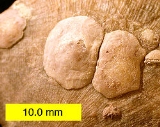
Craniidae
Encyclopedia
The Craniidae are a family
of brachiopods (lamp shells). They are the only members of the order
Craniida and the monotypic
suborder Craniidina and superfamily
Cranioidea; consequently, the latter two taxa are presently redundant and not used very often. Valdiviathyris and Neoancistrocrania were sometimes separated in a family Valdiviathyrididae but this has turned out to be unjustified.
Most Craniidae are long-extinct forms known only from fossil
s like all other Craniforma
. However, some 20 species of this 470-million-year-old lineage are extant today. They include Valdiviathyris quenstedti which has remained essentially unchanged for the last 35 million years or so. Although some minimal evolution
would obviously have taken place in the meantime, this was essentially silent mutation
s and marginal adaptations to cooler habitat
. Present-day Valdiviathyris are all but inseparable from those of the Late Eocene
and the genus
cannot even be divided into chronospecies
. Thus, V. quenstedti is a true living fossil
and one of the oldest and most long-lived species
known to science.
Family (biology)
In biological classification, family is* a taxonomic rank. Other well-known ranks are life, domain, kingdom, phylum, class, order, genus, and species, with family fitting between order and genus. As for the other well-known ranks, there is the option of an immediately lower rank, indicated by the...
of brachiopods (lamp shells). They are the only members of the order
Order (biology)
In scientific classification used in biology, the order is# a taxonomic rank used in the classification of organisms. Other well-known ranks are life, domain, kingdom, phylum, class, family, genus, and species, with order fitting in between class and family...
Craniida and the monotypic
Monotypic
In biology, a monotypic taxon is a taxonomic group with only one biological type. The term's usage differs slightly between botany and zoology. The term monotypic has a separate use in conservation biology, monotypic habitat, regarding species habitat conversion eliminating biodiversity and...
suborder Craniidina and superfamily
Taxonomic rank
In biological classification, rank is the level in a taxonomic hierarchy. Examples of taxonomic ranks are species, genus, family, and class. Each rank subsumes under it a number of less general categories...
Cranioidea; consequently, the latter two taxa are presently redundant and not used very often. Valdiviathyris and Neoancistrocrania were sometimes separated in a family Valdiviathyrididae but this has turned out to be unjustified.
Most Craniidae are long-extinct forms known only from fossil
Fossil
Fossils are the preserved remains or traces of animals , plants, and other organisms from the remote past...
s like all other Craniforma
Craniforma
Craniata is a class of Brachiopod originating in the Cambrian and still extant today. They have calcitic inarticulated shells that are subcircular in outline. This subphylum of brachiopod has an unsupported lophophore and is always attached to a hard substrate in the fossil record. This hard...
. However, some 20 species of this 470-million-year-old lineage are extant today. They include Valdiviathyris quenstedti which has remained essentially unchanged for the last 35 million years or so. Although some minimal evolution
Evolution
Evolution is any change across successive generations in the heritable characteristics of biological populations. Evolutionary processes give rise to diversity at every level of biological organisation, including species, individual organisms and molecules such as DNA and proteins.Life on Earth...
would obviously have taken place in the meantime, this was essentially silent mutation
Silent mutation
Silent mutations are DNA mutations that do not result in a change to the amino acid sequence of a protein. They may occur in a non-coding region , or they may occur within an exon in a manner that does not alter the final amino acid sequence...
s and marginal adaptations to cooler habitat
Habitat
* Habitat , a place where a species lives and grows*Human habitat, a place where humans live, work or play** Space habitat, a space station intended as a permanent settlement...
. Present-day Valdiviathyris are all but inseparable from those of the Late Eocene
Eocene
The Eocene Epoch, lasting from about 56 to 34 million years ago , is a major division of the geologic timescale and the second epoch of the Paleogene Period in the Cenozoic Era. The Eocene spans the time from the end of the Palaeocene Epoch to the beginning of the Oligocene Epoch. The start of the...
and the genus
Genus
In biology, a genus is a low-level taxonomic rank used in the biological classification of living and fossil organisms, which is an example of definition by genus and differentia...
cannot even be divided into chronospecies
Chronospecies
A chronospecies describes a group of one or more species derived from a sequential development pattern which involves continual and uniform changes from an extinct ancestral form on an evolutionary scale. This sequence of alterations eventually produces a population which is physically,...
. Thus, V. quenstedti is a true living fossil
Living fossil
Living fossil is an informal term for any living species which appears similar to a species otherwise only known from fossils and which has no close living relatives, or a group of organisms which have long fossil records...
and one of the oldest and most long-lived species
Species
In biology, a species is one of the basic units of biological classification and a taxonomic rank. A species is often defined as a group of organisms capable of interbreeding and producing fertile offspring. While in many cases this definition is adequate, more precise or differing measures are...
known to science.

